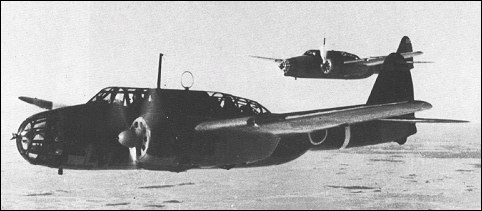 |
Kawasaki Ki-48 LILY1939 |  |
| LIGHT BOMBER | Virtual Aircraft Museum / Japan / Kawasaki |
 |
Imperial Japanese Army aircraft confronted by the Soviet-built Tupolev SB-2 bomber, providing support for the Chinese during 1937, were rudely surprised by its capability, its maximum speed being such that Japanese army fighter aircraft were virtually unable to intercept it. Almost at once the army instructed Kawasaki to begin the design of a twin-engine light bomber of even better capability, specifying a maximum speed of about 485km/h. Work on what was to become known as the Kawasaki Ki-48 began in January 1938, the result being a cantilever mid-wing monoplane with conventional tail unit, retractable tailwheel landing gear and, in the type's prototype form, two 708kW Nakajima Ha-25 radial engines mounted in nacelles at the wing leading edges. The fuselage provided accommodation for a crew of four (the bombardier, navigator and radiooperator each doubling as gunners) and incorporated an internal bomb bay. Ki-48s entered service in the summer of 1940, becoming operational in China during the autumn of that year. In China their speed gave the Ki-48s almost complete immunity from enemy defences, but their deployment against Allied aircraft at the beginning of the Pacific war revealed that their superior performance was illusory. Codenamed 'Lily' by the Allies, this initial production version had a number of deficiencies for the different kind of operations then required, and it was fortunate for the Japanese army that an improved version was already under development. This had the company designation Ki-48-II and differed from the earlier model by introducing a slightly lengthened fuselage, protected fuel tanks, armour protection for the crew, increased bombload and more powerful Nakajima Ha- 115 engines. Unfortunately for the Japanese army, when the Ki-48-II was introduced into operational service its speed was still too low and its defensive armament inadequate. Attempts to increase armament merely upped the overall weight and speed suffered proportionately: it was clear by the summer of 1944 that the day of the Ki-48 had passed, and in October it was declared obsolescent.

|  COMPANY PROFILE | |||||||||||||||||||||||||||||||||||||||||||||||||||||||||||||||
 |

|

